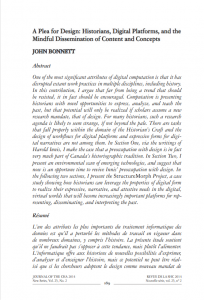Publications
Articles
A Plea for Design
Historians, Digital Platforms, and the Mindful Dissemination of Content and Concepts
Journal of the Canadian Historical Association 25(2): 189-231.
Abstract: One of the most significant attributes of digital computation is that it has disrupted extant work practices in multiple disciplines, including history. In this contribution, I argue that, far from being a trend that should be resisted, it in fact should be encouraged. Computation is presenting historians with novel opportunities to express, analyze, and teach the past, but that potential will only be realized if scholars assume a new research mandate, that of design. For many historians, such a research agenda is likely to seem strange, if not beyond the pale. There are tasks that fall properly within the domain of the Historian’s Craft and the design of workflows for digital platforms and expressive forms for digital narratives are not among them. In Section One, via the writings of Harold Innis, I make the case that a preoccupation with design is in fact very much part of Canada’s historiographic tradition. In Section Two, I present an environmental scan of emerging technologies, and suggest that now is an opportune time to revive Innis’ preoccupation with design. In the following two sections, I present the StructureMorph Project, a case study showing how historians can leverage the properties of digital form to realize their expressive, narrative, and attestive needs in the digital, virtual worlds that will become increasingly important platforms for representing, disseminating, and interpreting the past.





